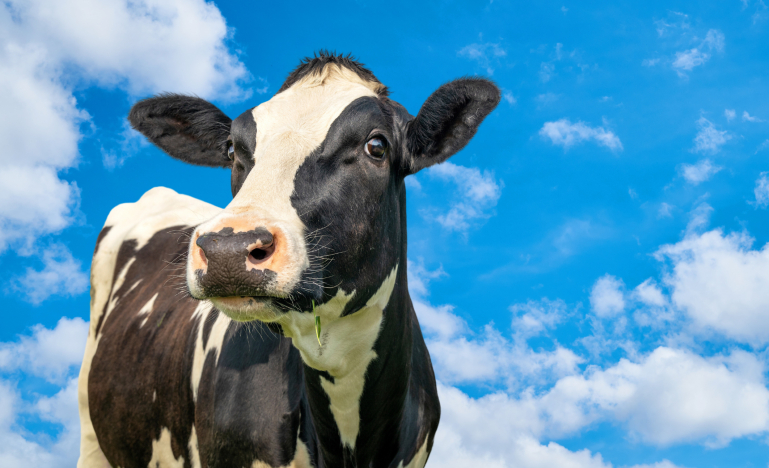Addressing the cow in the room
Canada's agriculture sector needs to focus on its environmental impacts as well as yields. We need better laws for that.

When it comes to fighting climate change, Glenn Wright tries to lead by example on his Saskatchewan grain farm. To reduce emissions, he turned off the natural gas in 2008, heating with geothermal instead. He added solar panels, retrofitted with insulation, and bought electric vehicles.
On the land, he's embraced minimum input and reduced tillage farming techniques. It involves less fertilizer and soil disturbance, increased perennial cover and adopted intercropping and companion planting. Wright uses biological processes to source nutrients instead of inorganic nitrogen fertilizer produced from natural gas – one of industrial agriculture's most significant emissions contributors.
He estimates his family has reduced its household emissions by 10 metric tonnes per year and their 800-acre farm's by 50 metric tonnes yearly.
"We decided we were going to do as much as we could to decarbonize, so we've been early adopters," Wright says. "But we are very much ridiculed as black sheep in Saskatchewan."
After 15 years of trying to inspire change, he's exhausted and struggles with people's refusal to accept climate change science. He sits on the board of directors of the Saskatchewan Barley Crop Commission, the Western Grants Research Foundation and the National Farmers Union. He says very few people are considering decarbonizing agriculture as an opportunity or something that needs to happen.
"People keep saying we cannot do anything green if we're not in the black, and the only way to be on the profit side of the ledger for farmers is to focus on yields," Wright says.
"For the last half-century, we've just focused on yields. Now we need to start focusing on carbon and emissions intensity."
While some change may come from economic new technologies, Wright says there's a real need for government action and policy.
It's why he went to law school after 20 years as an engineer, with climate advocacy as his motivation. He practises at Wardell Gillis in Saskatoon and is focused on pursuing strategic climate legislation against the government.
He recently launched a court action on behalf of Climate Justice Saskatoon, which aims to force SaskPower, a Crown corporation, to halt the development of new natural gas-fired power plants. The plaintiffs claim that in moving ahead with the two plants, the government would exacerbate the harm and intensity of climate change, which infringes on their Charter of Rights and Freedoms, specifically the right to life, liberty and security of the person.
Their lawsuit calls on the court to order the power company to prepare formal plans to decarbonize the provincial electrical grid and set "reasonable" targets to achieve net-zero carbon emissions by 2035.
In Saskatchewan and beyond, there is no shortage of action to be taken.
The agriculture sector is among the top producers of greenhouse gasses (GHGs) in Canada, with crop and livestock production accounting for 10% of the country's emissions. That doesn't include emissions from using fossil fuels and fertilizer production.
Ag is also a significant driver of biodiversity loss, land degradation and nonpoint source pollution in water.
Despite this, a recent report from AEL Advocacy, which focused on animal agriculture, has found most Canadian jurisdictions need better environmental protection legislation to address the impacts effectively.
The report, produced with World Animal Protection, sets out the findings of a legislative review of laws in select Canadian jurisdictions (Ontario, British Columbia, Manitoba, Quebec, New Brunswick and Nova Scotia), as well as several international jurisdictions (California, Australia and the United Kingdom).
No reviewed province has a comprehensive legislative framework dealing with agriculture pollution. Instead, there is a patchwork of laws, policies and regulations that deal with isolated issues––such as nutrient runoff, drinking water safety, waste management, and general environmental contamination.
"There isn't a whole lot out there, and what does exist is pretty fragmented," says Krystal-Anne Roussel, co-director and counsel at AEL.
There are also exemptions for the sector in the legislation and regulations that do exist. For instance, environmental assessment legislation generally doesn't apply to new animal agriculture projects and expansions. There are also exemptions from GHG emissions regulations.
When asked why animal agriculture projects aren't covered, Ontario's Ministry of the Environment, Conservation and Parks said they are "primarily regulated by legislation administered by the Ontario Ministry of Agriculture, Food and Rural Affairs."
When asked the same question, OMAFRA deferred to the environment ministry.
In many cases, broad, discretionary language leaves large legislative holes. While Ontario's Environmental Protection Act prohibits releasing contaminants likely to cause an "adverse effect," it exempts animal waste disposed during "normal farming practices."
There's also poor enforcement of existing environmental legislation concerning agriculture. Even when inspections are done and farms are found to be non-compliant, Roussel says it's rare that there are consequences.
For instance, Manitoba has the strongest provincial air pollution laws, requiring GHG reduction goals to be set and annual reporting. Emissions must be considered when issuing construction or operating licences for dairy or meat processing plants. Yet the most recent Manitoba Conservation and Climate Report for 2020-2021 doesn't address emissions from animal agriculture.
Agricultural exceptionalism is widespread in climate change efforts. Roussel thinks the reason is economic, as the sector provides food and jobs to many.
"There's this sense that we need to protect it and that if these laws are opened up to capture things that happen in animal agriculture, there would need to be significant shifts in the way things are done," she says.
However, Wright says even the Paris Agreement exempted agriculture, which "delayed the focus on the emissions intensity" of the sector and food system.
Canada's carbon pricing legislation includes agriculture exemptions around gasoline and light fuel oil costs used in tractors and trailers. Last month, the House of Commons passed a private member's bill that exempts farmers from paying for emissions from natural gas and propane.
Lynn Kavanagh, farming campaign manager at World Animal Protection, calls it "the cow in the room." Driving intensive animal agriculture's environmental harm is an unsustainable demand for animal protein. Collectively, the world needs to reduce its meat consumption.
"It's not just us saying that," she says. "There's a whole host of bodies saying we cannot reduce our greenhouse gas emissions enough with our current model given how much animal products we eat."
While Canada aims to reduce emissions 40% below 2005 levels by 2030 and reach net-zero emissions by 2050, Kavanagh says as things stand, "it's not going to happen." By granting legislative exemptions, governments only encourage more intensification in the ag sector.
She hopes the federal sustainable agriculture strategy, coming later this year, will do more to recognize and address environmental impacts, given its focus on soil health, climate adaptation and resilience, water, climate change mitigation, and biodiversity.
In the meantime, the AEL report calls for a shift away from legislative exemptions to motivate farmers to implement best practices and move away from intensive animal use.
Reducing and restructuring the billions in government subsidies could support better environmental practices by making funds conditional on demonstrated efforts to reduce ecological footprints, waste and emissions.
That's what the UK did with the Agriculture Act, which rewards farmers for managing land, water and livestock in ways that protect or improve the environment, mitigate climate change and promote animal welfare.
Wright says best practices depend on energy, so it's critical fossil fuels are replaced with clean energy – something currently hindered by a "crisis of imagination."
"Most farmers cannot envision harvesting or pulling their 100-foot seed drill without diesel fuel," he says
If people can't imagine it, it won't happen as fast as it needs to. Wright doesn't see a clean energy alternative that's not based on electrification, which is why the federal government must fund the expansion of the electrical grid. In Saskatchewan, natural gas infrastructure can handle five times the energy the electrical grid can. For the ag sector to electrify, that grid must grow.
As the climate clock ticks, Wright worries that those with the most influence and corporate interests don't have the public interest in mind.
"They're people who have really benefited from the way things are," he says.
"I'm just a messenger. I get a lot of bullet holes. I wish I could just be a farmer, but I can't watch Rome burn and pretend it's not happening."


